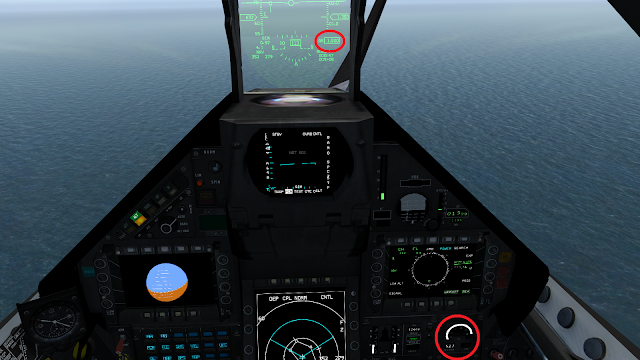Fuel management
This is the big part of the flight : getting familiar with the fuel management procedures. To deal with it I referred to a post on check-six forums by DeeJay which explains all the different terms in use : Bingo, Safety fuel...The fact is that I couldn't find any value on the web about Mirage 2000-5's consumption. So had I to find them by myself. To do so, I used a fully loaded plane (2 IR missiles, 4 EM missiles and 2 external 2000 liters fuel tanks). So I will start with 13700lb of kerosene.
First measurement is carried out from the cold and dark start to the taking off, including taxi. During all this time the throttle is left on idle.
 |
| Idle throttle on the ground |
Then as I use full afterburner to take off, another 300lb are gone when I'm airborne as we can see on the picture below.
 |
| Fuel left after take off |
Next step was to measure the fuel flows at 360 kts, 450 kts and full afterburner at altitudes of 1500 ft and 20,000 ft
Here are a couple of pictures taken during the test :
 |
| Full afterburner, 1500 ft and 52,300 lb/h |
 |
| Full afterburner, 20,000 ft and 34,900 lb/h |
 |
| 450 kts, 1500 ft and 9,300 lb/h |
at 1500 ft :
- 360 kts (mach 0,56) : 7,000 lb/h
- 450 kts (mach 0,7) : 9,300 lb/h
- full afterburner : 52,300 lb/h
at 20,000 ft :
- 360 kts : 6,000 lb/h
- 450 kts : 10,600 lb/h (!)
- full afterburner : 34,900 lb/h
But the fuel is now running low and it's time to go back home to land and ask for more advice on the Check-six forum.
In the discussion, I got an answer by Topolo who worked a lot on simulated flight models of the Mirage 2000. He sent me a link to its performance charts which where used to develop the simulated plane. I could then compare with my results and I was pleased to notice that my values are credibles (all except one of course). In these charts, the speed is measured in mach not in kts, so I'm gonna work with mach from now.
I would recommend everybody to check these charts out. Beyond fuel flows one can find best autonomy or endurance speed at each altitude... It's gonna be really useful for the following of the fuel management process !
In the next flight I will carry out further more measurements to fulfill my documentation. I need the fuel required to ascend to FL350 (standard departure and interception) and in case of aborted landing.

No comments:
Post a Comment